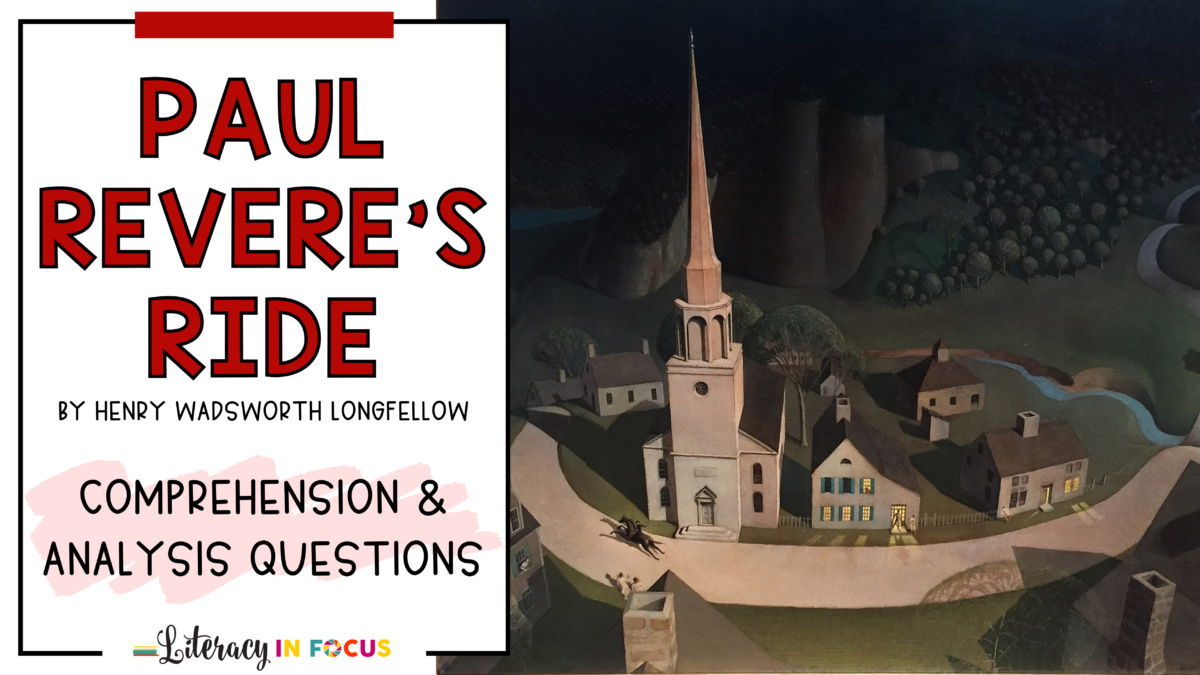“Paul Revere’s Ride” Comprehension & Analysis
Improve student understanding of Henry Wadsworth Longfellow’s poem, “Paul Revere’s Ride” with these standards-aligned comprehension and analysis questions. Use the activities listed below to build your own lesson plan or create worksheets for “Paul Revere’s Ride.” Click here to download the FREE printable PDF of the “Paul Revere’s Ride” poem.

Comprehension Questions
The questions listed below are standards-aligned and text-based. Use these questions to assess understanding before digging deeper into a more complex analysis of the poem.
- In what year did Paul Revere make his famous midnight ride?
- How many lanterns did Paul Revere tell his friend to hang if the British come by sea?
- Where did Paul Revere say he would wait for his friend’s signal?
- List three things Paul Revere’s friend sees from the church tower window.
- According to the poem, which towns does Paul Revere ride through, warning Americans of the British attack?
- What is Paul Revere thinking about as he rides through Concord?
Sequence of Events
Have students place the following events from the poem in the correct order.
- Paul Revere crosses the bridge into Medford town.
- Paul Revere rides his horse along the Mystic River.
- Paul Revere’s friend hears the British soldiers marching.
- Paul Revere sees a second lantern in the church tower.
- Paul Revere’s friend climbs the church tower.
Text Evidence
After building a strong foundation of understanding, your students will be ready to use critical thinking skills to cite textual evidence in response to a specific question or prompt.
- Write a line from the poem that shows Paul Revere was ready to start his ride.
- Write a line from the poem that shows Paul Revere’s ride was successful.
Analysis
The analysis questions listed below require a deeper understanding of the poem. Questions are focused on rhyme scheme, literary devices, and author’s purpose.
- Identify the rhyme scheme used in the lines below.
In the hour of darkness and peril and need,
The people will waken and listen to hear
The hurrying hoof-beats of that steed,
And the midnight message of Paul Revere.
- Longfellow uses a simile when he compares the shadow of the British ship masts to a prison bar. What is the deeper meaning behind this comparison? Hint: Think about the causes of the Revolutionary War.
- Longfellow uses personification to describe the windows Paul Revere passes in Lexington. What do the windows already seem to know as they watch Paul Revere ride through the town?
- What does Longfellow mean when he describes Revere’s message as “A cry of defiance, and not of fear”?
- Is Paul Revere a hero? Why or why not? Use evidence from the poem to support your answer.
“Great resource for a great poem. Students were engaged and able to follow along. The questions are perfect to help with comprehension. Thank you!” -Giulia L.








